Flavonoids Extraction Kinetics, Antimicrobial Activity and Radical Scavenging Potential of Bulgarian Woundwort (Solidago virgaurea L.)
Abstract
1. Introduction
2. Materials and Methods
2.1. Chemicals
2.2. Plant Material
2.3. Extraction Procedure
2.4. RP-HPLC-PDA Analyses
2.5. FT-IR Analyses
2.6. Antimicrobial Screening
2.7. In Vitro Antioxidant Activity
2.8. UV-B Treatment
2.9. Statistical Analysis
3. Results and Discussion
3.1. RP-HPLC Analyses of Woundwort Extracts and Extraction Kinetics Curves
3.2. FT-IR Analyses
3.3. Antibacterial Activity of Woundwort Extracts
3.4. Antioxidant Activity and Radical-Scavenging Potential of Woundwort Extracts
3.5. DPPH Scavenging Activity
3.6. ABTS•+ Radical Scavenging Activity
3.7. Reducing Power Activity
3.8. Nitric Oxide Scavenging Assay
4. Conclusions
Supplementary Materials
Author Contributions
Funding
Institutional Review Board Statement
Informed Consent Statement
Data Availability Statement
Conflicts of Interest
References
- Nasseri, M.A.; Behravesh, S.; Allahresani, A.; Kazemnejadi, M. Phytochemical and antioxidant studies of Cleome heratensis (Capparaceae) plant extracts. Bioresour. Bioprocess. 2019, 6, 5. [Google Scholar] [CrossRef]
- Szerlauth, A.; Muráth, S.; Viskic, S.; Szilagyi, I. Radical scavenging activity of plant extracts from improved processing. Heliyon 2019, 5, e02763. [Google Scholar] [CrossRef]
- Saeed, N.; Khan, M.R.; Shabbir, M. Antioxidant activity, total phenolic and total flavonoid contents of whole plant extracts Torilis leptophylla L. BMC Complement. Altern. Med. 2012, 12, 221. [Google Scholar] [CrossRef]
- Chaves, J.O.; de Souza, M.C.; da Silva, L.C.; Lachos-Perez, D.; Torres-Mayanga, P.C.; Machado, A.P.d.F.; Forster-Carneiro, T.; Vázquez-Espinosa, M.; González-de-Peredo, A.V.; Barbero, G.F.; et al. Extraction of flavonoids from natural sources using modern techniques. Front. Chem. 2020, 8, 507887. [Google Scholar] [CrossRef]
- Zhou, J.; Yang, Q.; Zhu, X.; Lin, T.; Hao, D.; Xu, J. Antioxidant activities of Clerodendrum cyrtophyllum Turcz leaf extracts and their major components. PLoS ONE 2020, 15, e0234435. [Google Scholar] [CrossRef] [PubMed]
- Yu, M.; Gouvinhas, I.; Rocha, J.; Barroset, A.I.R.N.A. Phytochemical and antioxidant analysis of medicinal and food plants towards bioactive food and pharmaceutical resources. Sci. Rep. 2021, 11, 10041. [Google Scholar] [CrossRef]
- Al-Rifai, A.; Aqel, A.; Al-Warhi, T.; Wabaidur, S.M.; Al-Othman, Z.A.; Badjah-Hadj-Ahmed, A.Y. Antibacterial, antioxidant activity of ethanolic plant extracts of some Convolvulus species and their DART-TOF-MS profiling. Evid.-Based Complementary Altern. Med. 2017, 2017, 5694305. [Google Scholar] [CrossRef]
- Onivogui, G.; Letsididi, R.; Diaby, M.; Wang, L.; Song, Y. Influence of extraction solvents on antioxidant and antimicrobial activities of the pulp and seed of Anisophyllea laurina R. Br. ex Sabine fruits. Asian Pac. J. Trop. Biomed. 2016, 6, 20–25. [Google Scholar] [CrossRef]
- Gonelimali, F.D.; Lin, J.; Miao, W.; Xuan, J.; Charles, F.; Chen, M.; Hatab, S.R. Antimicrobial properties and mechanism of action of some plant extracts against food pathogens and spoilage microorganisms. Front. Microbiol. 2018, 9, 1639. [Google Scholar] [CrossRef] [PubMed]
- Dissanayake, D.M.I.H.; Perera, D.D.B.D.; Keerthirathna, L.R.; Heendeniya, S.; Anderson, R.J.; Williams, D.E.; Peiris, L.D.C. Antimicrobial activity of Plumbago indica and ligand screening of plumbagin against methicillin-resistant Staphylococcus aureus. J. Biomol. Struct. Dyn. 2020. [Google Scholar] [CrossRef]
- Manandhar, S.; Luitel, S.; Dahal, R.K. In vitro antimicrobial activity of some medicinal plants against human pathogenic bacteria. J. Trop. Med. 2019, 2019, 1895340. [Google Scholar] [CrossRef]
- Owusu, E.; Ahorlu, M.M.; Afutu, E.; Akumwena, A.; Asare, G.A. Antimicrobial activity of selected medicinal plants from a Sub-Saharan African country against bacterial pathogens from post-operative wound infections. Med. Sci. 2021, 9, 23. [Google Scholar] [CrossRef]
- Tungmunnithum, D.; Thongboonyou, A.; Pholboon, A.; Yangsabai, A. Flavonoids and other phenolic compounds from medicinal plants for pharmaceutical and medical aspects: An Overview. Medicines 2018, 5, 93. [Google Scholar] [CrossRef]
- Al-Trad, B.; Al-Qudah, M.A.; Al-Zoubi, M.; Al-Masri, A.; Muhaidat, R.; Qar, J.; Alomari, G.; Alrabadi, N.I. In-vitro and in-vivo antioxidant activity of the butanolic extract from the stem of Ephedra alte. Biomed. Pharmacol. J. 2018, 11, 1239–1245. [Google Scholar] [CrossRef]
- Moraisi, G.; Ireri, A.; Ngugi, M.P. In vitro antioxidant activities of the aqueous and methanolic stem bark extracts of Piliostigma thonningii (Schum.). J. Evid.-Based Integr. Med. 2020, 25, 1–9. [Google Scholar] [CrossRef]
- Zagórska-Dziok, M.; Ziemlewska, A.; Nizioł-Łukaszewska, Z.; Bujak, T. Antioxidant activity and cytotoxicity of Medicago sativa L. seeds and herb extract on skin cells. BioRes. Open Access 2020, 9, 229–242. [Google Scholar] [CrossRef]
- Fursenco, C.; Calalb, T.; Uncu, L.; Dinu, M.; Ancuceanu, R. Solidago virgaurea L.: A Review of its ethnomedicinal uses, phytochemistry, and pharmacological activities. Biomolecules 2020, 10, 1619. [Google Scholar] [CrossRef]
- Jasicka-Misiak, I.; Makowicz, E.; Stanek, N. Chromatographic fingerprint, antioxidant activity, and colour characteristic of polish woundwort (Solidago virgaurea L.) honey and flower. Eur. Food Res. Technol. 2018, 244, 1169–1184. [Google Scholar] [CrossRef]
- Yaneva, Z.; Ivanova, D.; Beev, G.; Besheva, K. Quantification of catechin in Acacia catechu extract by non-derivative, first derivative UV/Vis spectrophotometry and FT-IR spectroscopy. Bulg. Chem. Commun. 2020, 52, 41–47. [Google Scholar]
- Yaneva, Z. Development of a new precise and sensitive analytical method for quercetin quantification. Proc. Univ. Ruse 2018, 57, 153–157. [Google Scholar]
- Kaneria, M.; Baravalia, Y.; Vaghasiya, Y.; Chanda, S. Determination of antibacterial and antioxidant potential of some medicinal plants from Saurashtra region, India. Indian J. Pharm. Sci. 2009, 71, 406–412. [Google Scholar] [CrossRef]
- Cuendet, M.; Hostettmann, K.; Potterat, O.; Dyatmiko, W. Iridoid glucosides with free radical scavenging properties from Fagraea blumei. Helv. Chim. Acta 1997, 80, 1144–1152. [Google Scholar] [CrossRef]
- Karamalakova, Y.; Sharma, J.; Sharma, R.K.; Gadjeva, V.; Kumar, R.; Zheleva, A. Comparative investigation on radical scavenging activity and protective properties of natural isolated and synthetic antioxidants. Biotechn. Biotechnol. Equipm. 2012, 26 (Suppl. 1), 175–179. [Google Scholar] [CrossRef][Green Version]
- Re, R.; Pellegrini, N.; Proteggente, A.; Pannala, A.; Yang, M.; Rice-Evans, C. Antioxidant activity applying an improved ABTS radical cation decolorization assay. Free Rad. Biol. Med. 1999, 26, 1231–1237. [Google Scholar] [CrossRef]
- Adhikary, M.; Karamalakova, Y.; Ivanov, V.; Gadjeva, V.; Kumar, R.; Sharma, R.; Zheleva, A.; Arora, R. A comparative evalution of an antioxidant of natural origin derived from Silybum marianum characterized by in vitro assay and electron paramagnetic resonance spectroscopy. Trakia J. Sci. 2012, 10 (Suppl. 1), 17–24. [Google Scholar] [CrossRef]
- Oyaizu, M. Studies on products of Browning reactions: Antioxidative activities of product of Browning reaction prepared from glucosamine. Jpn. J. Nutr. 1986, 44, 307–315. [Google Scholar] [CrossRef]
- Karamalakova, Y.; Sharma, J.; Nikolova, G.; Stanev, S.; Arora, R.; Gadjeva, V.; Zheleva, A. Studies on antioxidant properties before and after UV- And Γ-Irradiation of Bulgarian lavender essential oil isolated from Lavandula Angostifolia mill. Biotechnol. Biotechnol. Equipm. 2013, 27, 3861–3865. [Google Scholar] [CrossRef]
- Shirwaikar, A.; Prabhu, K.S.; Punitha, I.S. In vitro antioxidant studies of Sphaeranthus indicus (Linn). Indian J. Exp. Biol. 2006, 44, 993–996. [Google Scholar]
- Karamalakowa, Y.; Adhikary, M.; Kovacheva, N.; Ivanov, V.; Nikolova, G.; Gadjeva, V. Rose oil isolated from oil-bearing Rosa damascena Mill. As a protector against ionizing radiation-induced oxidative disorders. Bulg. Chem. Commun. 2018, 50, 14–19. [Google Scholar]
- Tzanova, M.; Atanasov, V.; Yaneva, Z.; Ivanova, D.; Dinev, T. Selectivity of current extraction techniques for flavonoids from plant materials. Processes 2020, 8, 1222. [Google Scholar] [CrossRef]
- Simeonov, E.; Yaneva, Z.; Chilev, C. Kinetics of green solid-liquid extraction of useful compounds from plant materials—Kinetics coefficients and modelling. Green Processing Synth. 2018, 7, 68–73. [Google Scholar] [CrossRef]
- Simeonov, E.; Yaneva, Z.; Chilev, C. Extraction of protodioscin from Tribulus terrestris—Optimisation of kinetics and modelling. Rev. Chim. 2020, 71, 56–66. [Google Scholar] [CrossRef]
- Koch, W.; Kukuła-Koch, W.; Czop, M.; Helon, P.; Gumbarewicz, E. The role of extracting solvents in the recovery of polyphenols from green tea and its antiradical activity supported by principal component analysis. Molecules 2020, 25, 2173. [Google Scholar] [CrossRef]
- Vuong, Q.V.; Golding, J.B.; Nguyen, M.; Roach, P.D. Extraction and isolation of catechins from tea. J. Sep. Sci. 2010, 33, 3415. [Google Scholar] [CrossRef] [PubMed]
- Tsai, Y.J.; Chen, B.H. Preparation of catechin extracts and nanoemulsions from green tea leaf waste and their inhibition effect on prostate cancer cell PC-3. Int. J. Nanomed. 2016, 11, 1907. [Google Scholar] [CrossRef]
- Brangule, A.; Šukele, R.; Bandere, D. Herbal medicine characterization perspectives using advanced FTIR sample techniques—Diffuse Reflectance (DRIFT) and Photoacoustic Spectroscopy (PAS). Front. Plant Sci. 2020, 11, 356. [Google Scholar] [CrossRef]
- Srinivas, K.; King, J.W.; Howard, L.R.; Monrad, J.K. Solubility and solution thermodynamic properties of quercetin and quercetin dihydrate in subcritical water. J. Food Eng. 2010, 100, 208–218. [Google Scholar] [CrossRef]
- Wang, Q.; Wei, H.; Deng, C.; Xie, C.; Huang, M.; Zheng, F. Improving stability and accessibility of quercetin in olive oil-in-soy protein isolate/pectin stabilized O/W emulsion. Foods 2020, 9, 123. [Google Scholar] [CrossRef] [PubMed]
- Porto, I.C.C.M.; Nascimento, T.G.; Oliveira, J.M.S.; Freitas, P.H.; Haimeur, A.; França, R. Use of polyphenols as a strategy to prevent bond degradation in the dentin-resin interface. Eur. J. Oral Sci. 2018, 126, 146–158. [Google Scholar] [CrossRef]
- Ke, F.; Zhang, M.; Qin, N.; Zhao, G.; Chu, J.; Wan, X. Synergistic antioxidant activity and anticancer effect of green tea catechin stabilized on nanoscale cyclodextrin-based metal–organic frameworks. J. Mater. Sci. 2019, 54, 10420–10429. [Google Scholar] [CrossRef]
- Watts, J.L.; Shryock, T.R.; Apley, M.; Bade, D.J.; Brown, S.D.; Gray, J.T.; Heine, H.; Hunter, R.P.; Mevius, D.J.; Papich, M.G.; et al. Performance Standards for Antimicrobial Disk and Dilution Susceptibility Tests for Bacteria Isolated from Animals, 3rd ed.; Clinical and Laboratory Standards Institute: Wayne, PA, USA, 2008; Volume 28, No 8; p. 99. [Google Scholar]
- Dinev, T.; Tzanova, M.; Rusenova, N.; Grozeva, N.; Gerdzhikova, M.; Beev, G. Antimicrobial and antioxidant potential of methanolic extracts from different parts of Stevia rebaudiana Bertoni cultivated in Bulgaria. Sains Malays. 2021, 50, 2641. [Google Scholar] [CrossRef]
- Gonçalves, V.S.S.; Poejo, J.; Matias, A.A.; Rodríguez-Rojo, S.; Coceroc, M.J.; Duarte, C.M.M. Using different natural origin carriers for development of epigallocatechin gallate (EGCG) solid 2 formulations with improved antioxidant activity by PGSS-drying. RSC Adv. 2016, 6, 67599–67609. [Google Scholar] [CrossRef]
- de Jager, T.L.; Cockrell, A.E.; Du Plessis, S.S. Ultraviolet light induced generation of reactive oxygen species. Adv. Exp. Med. Biol. 2017, 996, 15–23. [Google Scholar] [CrossRef]
- Nocchi, N.; Duarte, H.M.; Pereira, R.C.; Konno, T.U.P.; Soares, A.R. Effects of UV-B radiation on secondary metabolite production, antioxidant activity, photosynthesis and herbivory interactions in Nymphoides humboldtiana (Menyanthaceae). J. Photochem. Photobiol. B 2020, 212, 112021. [Google Scholar] [CrossRef] [PubMed]
- González-Palma, I.; Escalona-Buendía, H.B.; Ponce-Alquicira, E.; Téllez-Téllez, M.; Gupta, V.K.; Díaz-Godínez, G.; Soriano-Santos, J. Evaluation of the antioxidant activity of aqueous and methanol extracts of Pleurotus ostreatus in different growth stages. Front. Microbiol. 2016, 7, 1099. [Google Scholar] [CrossRef] [PubMed]
- Ebrahimzadeh, M.A.; Nabavi, S.F.; Nabavi, S.M.; Pourmorad, F. Nitric oxide radical scavenging potential of some Elburz medicinal plants. Afr. J. Biotechnol. 2010, 9, 5212–5217. [Google Scholar]
- Palacios-Callender, M.; Quintero, M.; Hollis, V.S.; Springett, R.J.; Moncada, S. Endogenous NO regulates superoxide production at low oxygen concentrations by modifying the redox state of cytochrome c oxidase. Proc. Natl. Acad. Sci. USA 2004, 101, 7630–7635. [Google Scholar] [CrossRef] [PubMed]
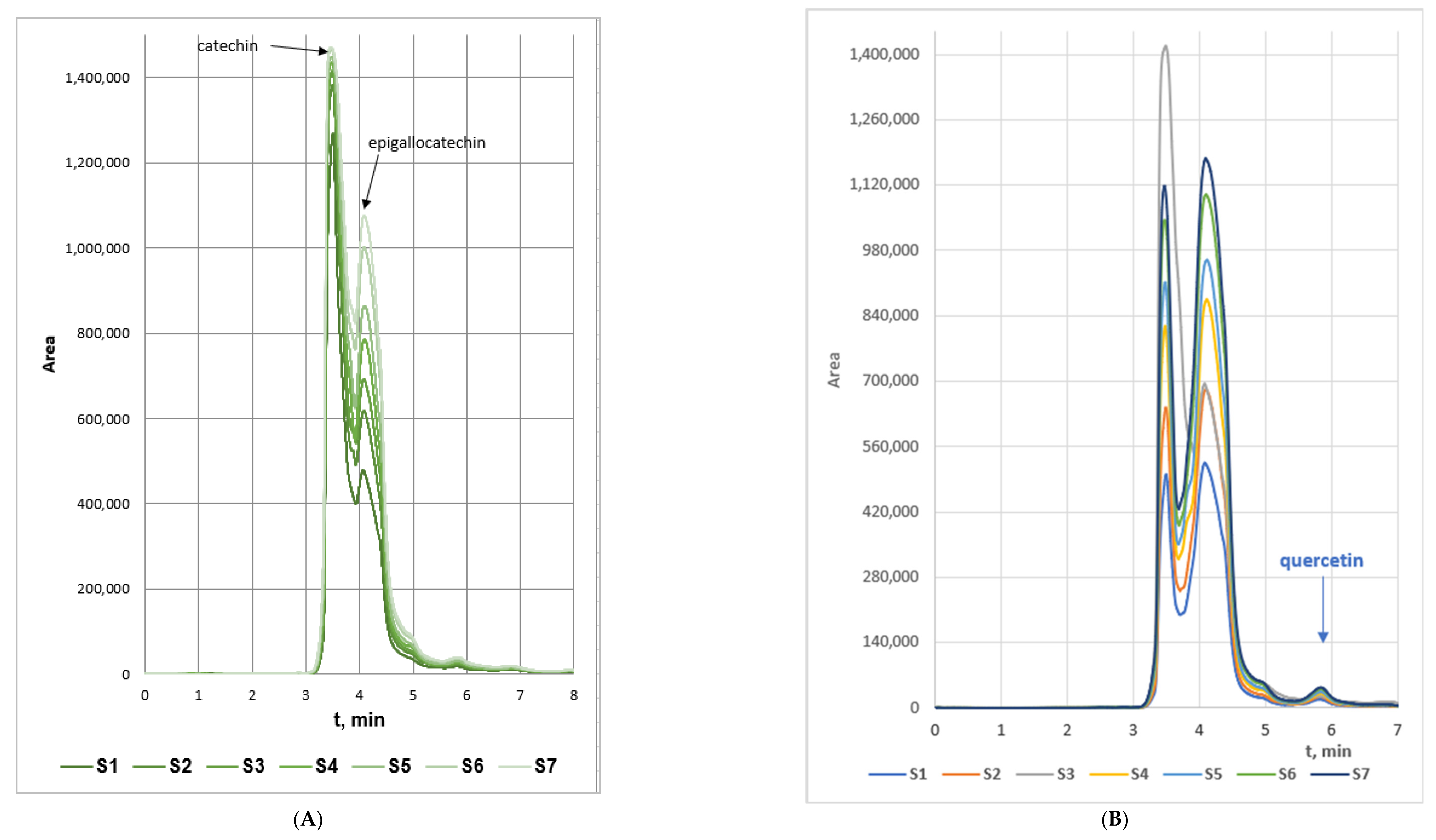
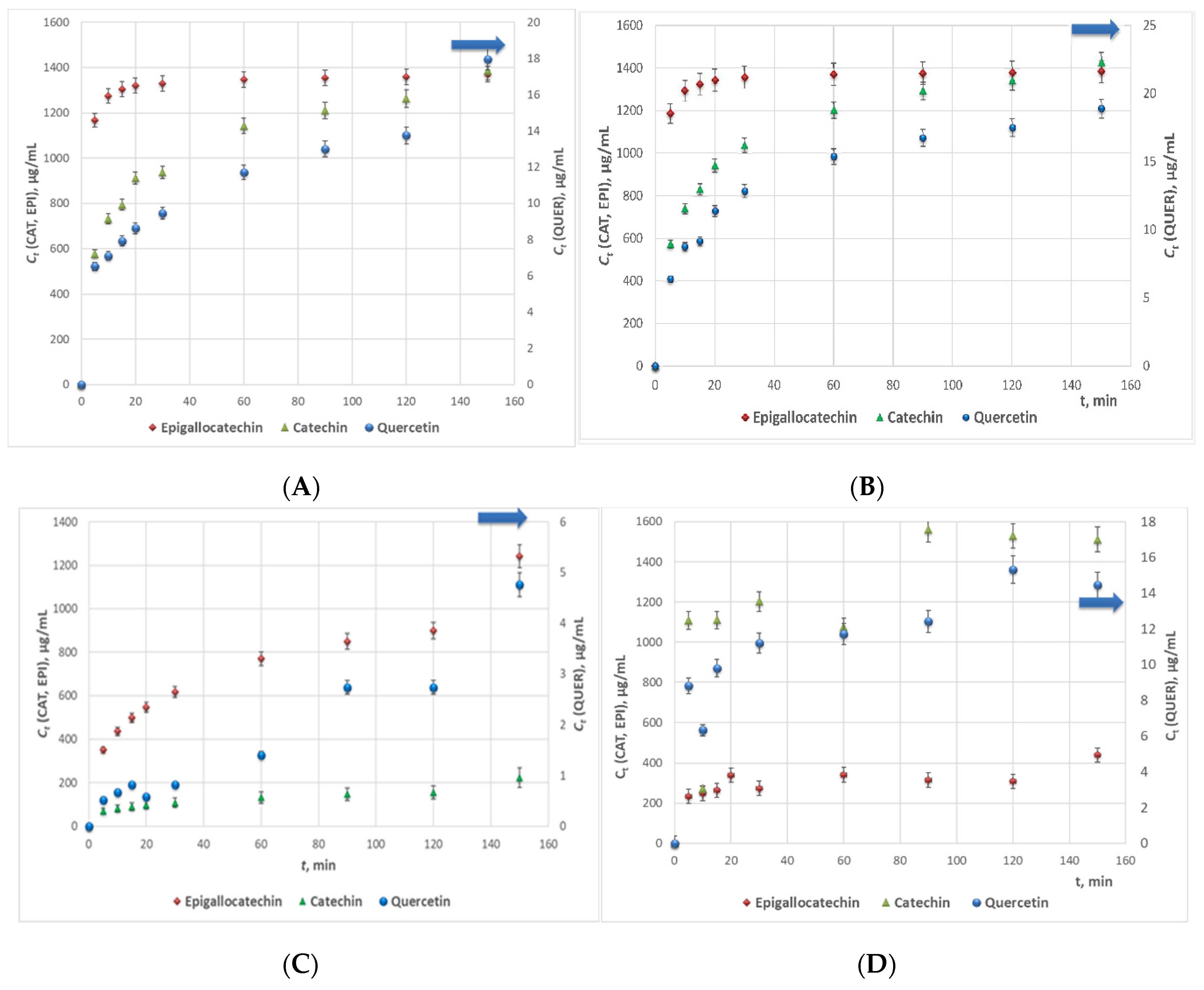
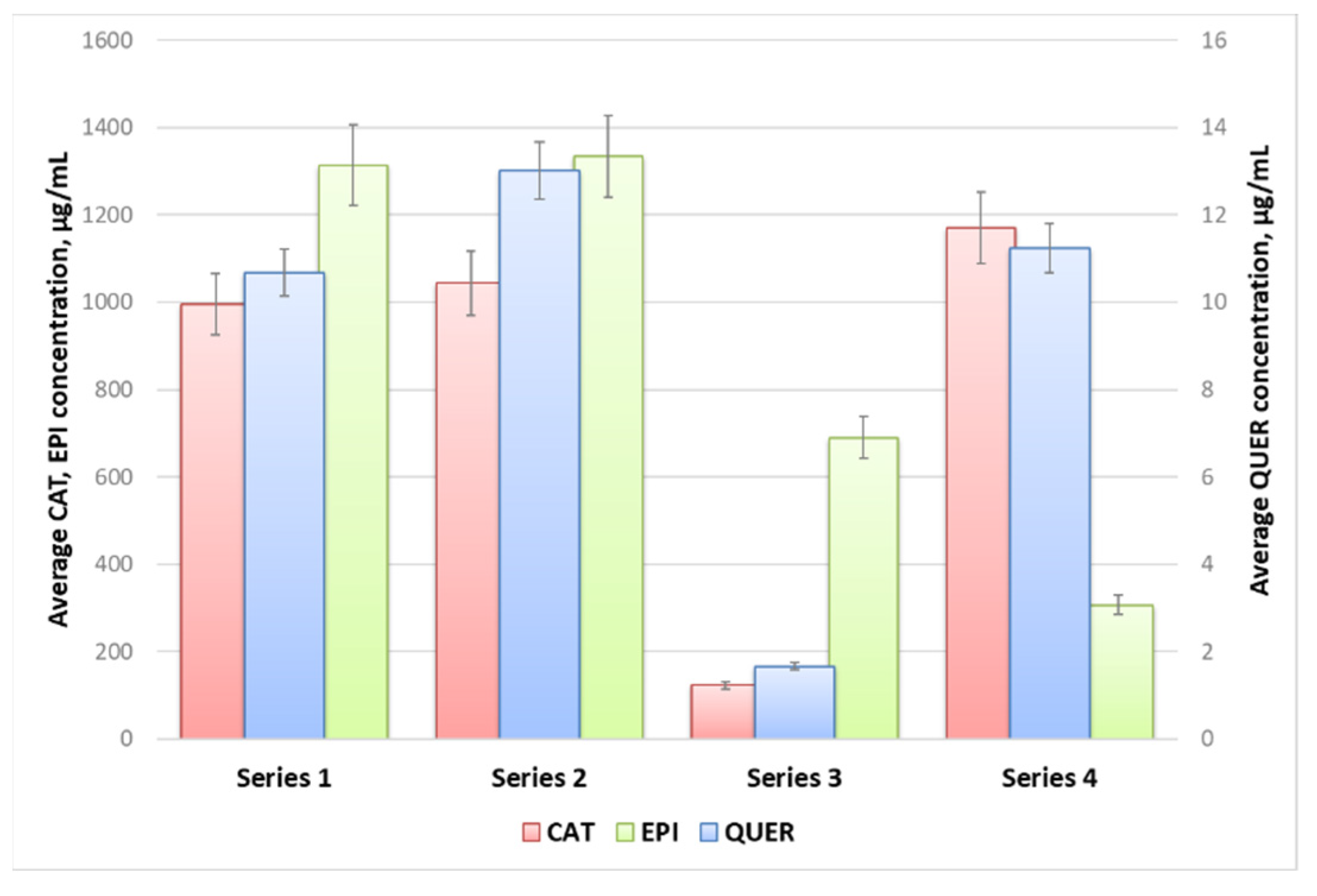
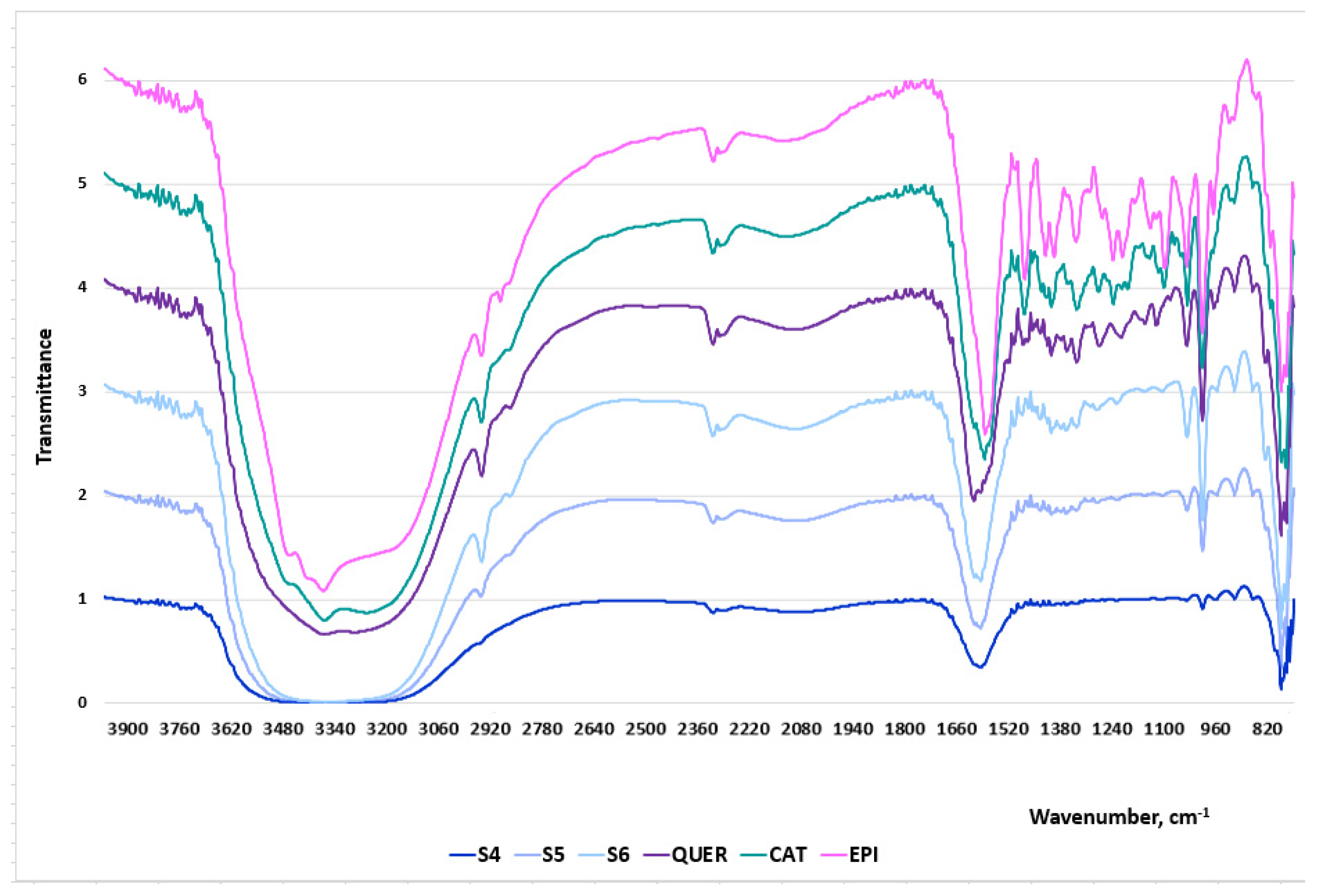
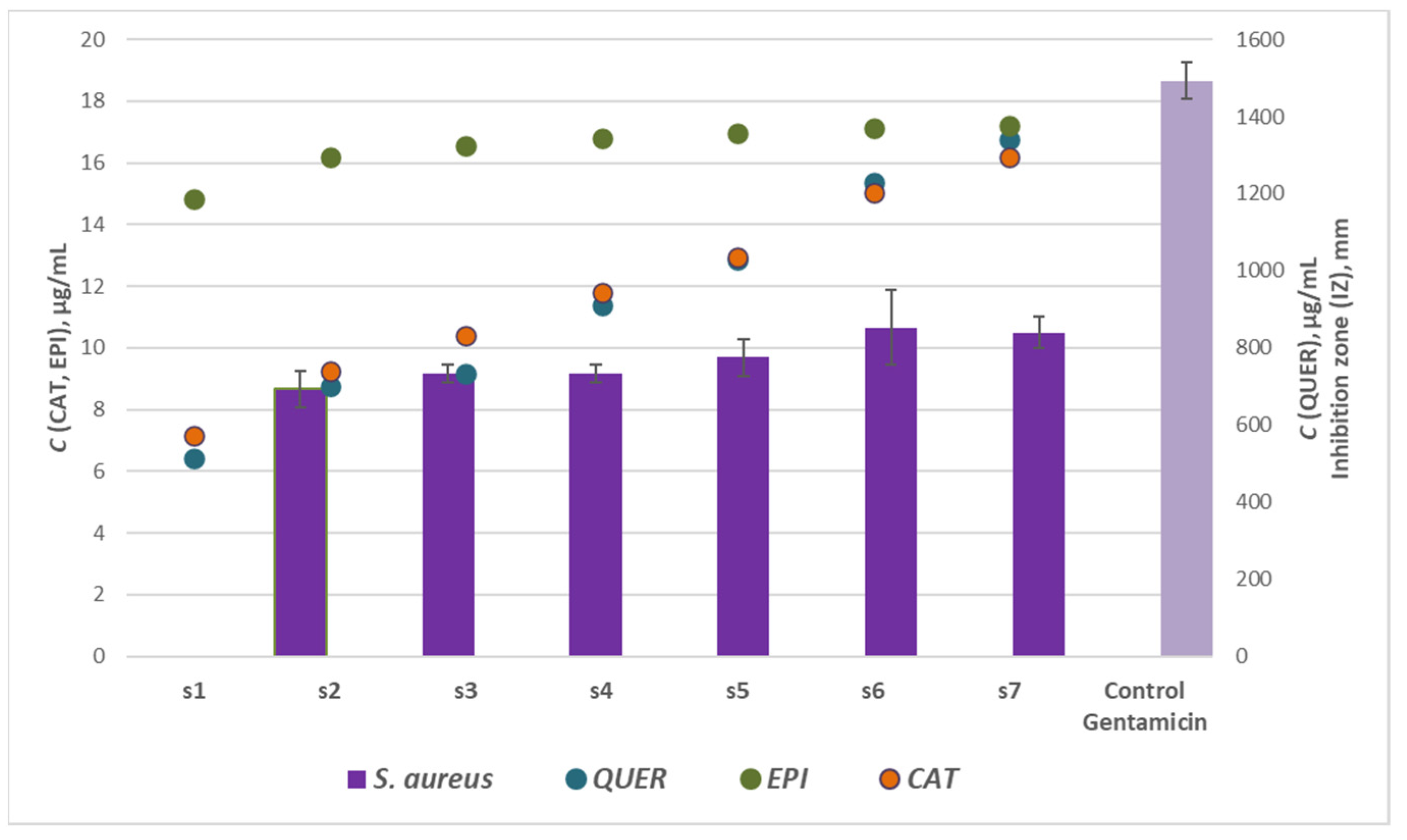

| Flavonoid | Quercetin | Catechin | Epigallocatechin |
|---|---|---|---|
| Mobile phase | MeOH:AcCN:H2O = 40:15:45 (v/v/v) (+1% CH3COOH) | ||
| Maximum wavelength | λ = 360 nm—for solvents water, 70% EtOH and 98% EtOH | λ = 260 nm—for solvent water; λ = 325 nm—for solvents 70% EtOH and 98% EtOH | |
| Flow rate | 0.5 mL/min | 0.5 mL/min | |
| Precolumn derivatization | + | + | |
| Column temperature | 30 °C | 30 °C | |
| Detection time | t = 5.8 min | t = 4.3 min | t = 3.5 min |
| Wavenumber Range (cm−1) Designation | 3500–3300 O–H Linkage of Phenolic Groups; Aromatic Ring Quadrant; Intermolecular H-Bonded Phenolic -OH Groups | 2360–2320 C–H-Stretching Vibrations in Aromatic Ring | 1690–1670 Medium Intensity Band of C=O Carbonyl Functional Group Stretching | 1660–1620 C=C Aromatic Ring Stretching Vibrations, Aromatic Quadrant Ring Stretch | 1600–1500 Aromatic Semicircle Ring Stretch; C=C Aromatic Bonds Stretching | 1500–1400 C–C Stretching of Aromatic Rings and C–H Bending | 1400–1300 C–O Alcohol Vibration; Aromatic Ring of the Phenolic Moiety; =C–O–H Stretching of the Phenolic Group | 1300–1000 C–O Stretching Vibrations; C–O-H Bending; Plane Bending Vibrations of Phenyl Group; H-Bonding; C=C–O Aromatic Ring Stretching | 1000–900 C–O–C Symmetric Stretching; C–H Aromatic Bending. H Out-of-Plane Deformation of an Aromatic Ring | 880–810 Aromatic Ring Vibrations; C–H Alkenes, Stretching of the Catechol Moiety |
|---|---|---|---|---|---|---|---|---|---|---|
Catechin | 3492, 3477, 3404 | 2358, 2331 | - | 1631, 1620 | 1558, 1529, 1523 | 1494, 1458, 1417 | 1342, 1325 | 1282–1016 | 975, 921 | 862, 835, 819 |
Epigallocatechin | 3483, 3473, 3404 | 2358, 2329 | - | 1627, 1620 | 1556, 1542, 1521 | 1488, 1456, 1417 | 1340, 1315 | 1284–1014 | 979, 923 | 862, 835, 823, 821 |
Quercetin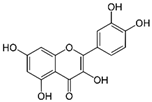 | 3404 | 2360, 2331 | 1685 | 1658, 1641 | 1558, 1526, 1523 | 1475, 1436, 1419 | 1338, 1321 | 1265–1014 | 972, 927 | 875, 835, 819 |
| Woundwort extracts | - | 2358–2356, 2329 | - | 1649, 1641 | 1560, 1539, 1519 | 1471, 1436, 1417 | 1359, 1338 | 1272-1006 | 975, 925 | 877, 835, 823 |
| Sample | Series 1 IZ | Series 2 IZ | Series 3 IZ | |||||||||
|---|---|---|---|---|---|---|---|---|---|---|---|---|
| S. aureus | P. aeruginosa | E. coli | B. cereus | S. aureus | P. aeruginosa | E. coli | B. cereus | St. aureus | P. aeruginosa | E. coli | B. cereus | |
| S1′/S1/S1″ | 12.8 ± 0.3 ** | 25.2 ± 1.0 *** | - | - | - | - | 8.8 ± 0.8 * | - | 9.0 ± 0.5 * | - | 8.5 ± 0.5 * | - |
| S2′/S2/S2″ | 17.2 ± 0.8 *** | 24.2 ± 0.8 *** | - | - | 8.7 ± 0.6 * | 8.7 ± 0.6 * | 8.3 ± 0.6 * | - | 9.5 ± 0.9 * | 8.8 ± 0.3 * | 8.7 ± 0.6 * | - |
| S3′/S3/S3″ | 21.0 ± 1.0 *** | 21.2 ± 0.8 *** | - | - | 9.2 ± 0.3 * | 8.8 ± 0.8 * | 8.7 ± 0.6 * | - | 9.7 ± 0.3 * | 8.5 ± 0.9 * | 9.5 ± 0.5 * | - |
| S4′/S4/S4″ | 11.7 ± 1.5 ** | 14.2 ± 1.0 ** | - | - | 9.2 ± 0.3 * | 9.7 ± 0.6 * | 9.2 ± 0.8 * | - | 9.7 ± 0.6 * | 9.3 ± 0.6 * | 8.8 ± 0.3 * | - |
| S5′/S5/S5″ | 16.8 ± 0.8 *** | 11.3 ± 1.5 ** | - | - | 9.7 ± 0.6 * | 9.5 ± 0.5 * | 8.5 ± 0.5 * | - | 9.0 ± 1.0 * | - | - | - |
| S6′/S6/S6″ | 14.8 ± 0.3 ** | - | - | - | 10.7 ± 1.2 * | 9.2 ± 0.8 * | 8.5 ± 0.9 * | - | 9.2 ± 1.0 * | - | - | - |
| S7′/S7/S7″ | 15.7 ± 0.6 *** | - | - | - | 10.5 ± 0.5 * | - | 9.7 ± 0.6 * | - | 10.3 ± 0.8 * | - | - | - |
| Positive control (gentamicin) | 17.2 ± 0.8 | 17.0 ± 0.5 | 16.2 ± 1.0 | 18.2 ± 0.8 | 18.7 ± 0.6 | 17.3 ± 0.6 | 16.8 ± 0.3 | 18.5 ± 0.5 | 18.2 ± 0.8 | 16.7 ± 0.6 | 16.5 ± 0.5 | 18.7 ± 0.3 |
| Negative control (70% EtOH; 98% EtOH) | 8.2 ± 0.3 | 7.5 ± 0.5 | 7.8 ± 0.3 | 10.8 ± 0.8 | 8.2 ± 0.3 | 7.5 ± 0.5 | 7.8 ± 0.3 | 10.8 ± 0.8 | 7.2 ± 0.3 | 7.5 ± 0.5 | 8.2 ± 0.5 | 9.8 ± 0.8 |
Publisher’s Note: MDPI stays neutral with regard to jurisdictional claims in published maps and institutional affiliations. |
© 2022 by the authors. Licensee MDPI, Basel, Switzerland. This article is an open access article distributed under the terms and conditions of the Creative Commons Attribution (CC BY) license (https://creativecommons.org/licenses/by/4.0/).
Share and Cite
Yaneva, Z.; Simeonov, E.; Rusenova, N.; Ivanova, D.; Nikolova, G.; Karamalakova, Y.; Chilev, C.; Beev, G. Flavonoids Extraction Kinetics, Antimicrobial Activity and Radical Scavenging Potential of Bulgarian Woundwort (Solidago virgaurea L.). Separations 2022, 9, 27. https://doi.org/10.3390/separations9020027
Yaneva Z, Simeonov E, Rusenova N, Ivanova D, Nikolova G, Karamalakova Y, Chilev C, Beev G. Flavonoids Extraction Kinetics, Antimicrobial Activity and Radical Scavenging Potential of Bulgarian Woundwort (Solidago virgaurea L.). Separations. 2022; 9(2):27. https://doi.org/10.3390/separations9020027
Chicago/Turabian StyleYaneva, Zvezdelina, Evgeni Simeonov, Nikolina Rusenova, Donika Ivanova, Galina Nikolova, Yanka Karamalakova, Chavdar Chilev, and Georgi Beev. 2022. "Flavonoids Extraction Kinetics, Antimicrobial Activity and Radical Scavenging Potential of Bulgarian Woundwort (Solidago virgaurea L.)" Separations 9, no. 2: 27. https://doi.org/10.3390/separations9020027
APA StyleYaneva, Z., Simeonov, E., Rusenova, N., Ivanova, D., Nikolova, G., Karamalakova, Y., Chilev, C., & Beev, G. (2022). Flavonoids Extraction Kinetics, Antimicrobial Activity and Radical Scavenging Potential of Bulgarian Woundwort (Solidago virgaurea L.). Separations, 9(2), 27. https://doi.org/10.3390/separations9020027










